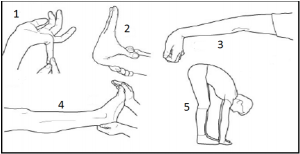Did you ever have quizzes when you were in school?I'm talking about surprises quizzes that were given without advance notice.[caption id="attachment_5529" align="aligncenter" width="300"] Pop quizzes were a good way to assess how well the class learned the basics.Usually they didn't count much toward your final grade but were important to get a quick pulse on how the class was doing. Did they learn the previous lesson? Can the teacher proceed with more advanced concepts?In other words, does the class understand the basics?Well, guess what it's quiz time!And the question is what is something most people want when it comes to their training but will neglect as well?The answer of course is stretching.And I would guess the reason stretching gets little attention is that it's not as appealing as a good strength or energy system training session.Bodybuilders, power and Olympic lifters all like the pump after a good lift.Aerobic athletes seek out 'the high' they get from a good ride, run, hike or swim.And once we've gotten what we need out of the training session there isn't much interest in stretching. It gets pushed to the side and ignored.But the irony is more and more people identify flexibility and mobility as their goal for training. Maybe they have restricted mobility which impacts their quality of life. For example, maybe a lack of shoulder mobility impairs an individual's ability to sleep at night. They may have nagging low back pain from tight hips and a weak core.So we know what we need but for whatever reason we are reluctant to give stretching and mobility the attention it deserves in our training program.This may be partly due to the fact most people train for a fat loss goal. They train to look better. They train to change the aesthetic which then helps with confidence and...
The What, How & Why of Warming Up
- Chris Collins
- Fitness
- 1830 Hits
- 0 Comments
-
Welcome to 2018! As we turn the calendar on a new year many will be embarking on a new fitness routine. With more people getting started in fitness there will be more injuries on the way. What can we do to make sure our fitness efforts are safe and effective?One of the things we want to make sure to do is to warm-up properly for exercise. If you've ever attended a track and field meet and watched the 100 m race you'll notice something.Although these athletes will only race for 10-12 seconds depending on the level, they will warm-up for much longer than that. Elite sprinters won't arrive at the track 30 minutes before their race to lace up and pull a heel to their glutes. Instead their warm-up could last hours. And this is to enhance their performance and to minimize injury.So what does a warm-up do?A warm-up helps accomplish a couple of things. It helps improve muscle dynamics so we are less inclined to injury It helps prepare us for the demands of sport (or exercise)Regarding reducing the rate of injury, over 30% of sports/training injuries are related to skeletal muscles so it makes sense that we would want to prepare them adequately for the demands to come.Are there different ways to warm-up?Well are the different ways and different types. In terms of types we can think of active and passive warm-ups. Active warm-ups are things we do ourselves by moving our bodies. And these can be general, like jogging or ridding the bike before a training session, or specific with movements that mimic the demands of the sport or activity.Warm-ups can also be passive where we are warmed by external means. This could be by sitting in a sauna or a hot tub or having a warm shower.Does the...
What to do about tight hamstrings
Ask 100 people that train where they are most tight and you will probably hear hamstrings singled out as one of the most common problem areas. I would include tight hips as well as the two are intimately related and if you have tight hamstrings more than likely have tight hips as well. So first of all, if this really a case of tight hamstrings? And, if so, what can you do about it? To answer the questions to these we need to go back the basics. This means evaluating a person's static posture. I like the way Dan John describes the relationship of the hips/pelvis and the rib cage. He says to imagine the hips/pelvis as a bowl of water with a box sitting on top. Does the bowl of water sit level? Or is there water leaking out of the front (anterior tilt) of the bowl? Or out of the back (posterior tilt)? Before we can even start to think of lengthening or shortening any of our tissues or structures we need to know that the foundation is solid. A quick and easy drill to learn the range of the hips and pelvis is the cat and camel. Starting on hands and knees imagine spilling water out of the front of the bowl. You should notice an increased arch through the low back. Next try and spill some water out of the back of the bowl. Dr. Jeff Cubos, who presented at the inaugural OSCC, used the analogy of trying to scoop ice cream with your butt. Use whichever analogy works for you. http://youtu.be/CXRsjICsGnc Once we have established a neutral hip and pelvic position we need to recognize that tight hamstrings may also be due to weak lower abs and/or hip flexors. Think about it this way. If you had...
Why stretching might be bad for you
It seems like there are certain things in life where there isn't such a thing as too much of a good thing.You know what I mean?For example, not too many people would say no to a raise at work. Or a few extra days on a vacation. Or to any of the things we work to achieve and be rewarded with.In the same way in fitness we can sometimes see certain aspects of training as being not only essential for everyone but that it would be impossible to do too much of them.Usually this goes hand in hand with the things we don't like to do during our training. This may include a proper warm up, or core training, energy system training or maybe even stretching.For many stretching tends to be the element of their training that gets neglected. We put in the reps and sets or go for our runs but then skip the cool down and post-workout stretch. I know I am guilty of this.And as we age and settle into jobs where we sit for a big part of the day and we notice a change in our mobility. It gets harder to touch our toes. We can't reach our arm behind us to scratch our back. Basically we notice that aren't as flexible as we once were.And we recognize the need for increased mobility and stretching to achieve this.But this may not be the best solution for everyone.Last fall I attended a clinic with Eric Cressey presenting in Seattle. (Graeme was at this event as was Megan). Anyways Eric talked about using a series of tests to the assess the mobility (or hyper mobility) of athletes using the Beighton Test.[caption id="attachment_3894" align="alignleft" width="300"] The 5 Beighton testsThe image above shows the 5 tests which involve:* bending the...
The Value of the Warm Up
- Chris Collins
- Fitness
- Training
- Injury Prevention
- 1819 Hits
- 0 Comments
-
So yesterday I had the chance the play a round of golf with a buddy, Jim, and he invited a couple of friends which was great. I actually knew one of the guys from many years ago at a gym in downtown Kelowna called Flex Fitness. Anybody remember that place? Anyways Jim and I planned to have lunch on the course and then hit a few balls before teeing off. Well we got involved in conversations about travel and other things that we didn't realize that we hadn't gotten our food and we had about 10 minutes until we were due up at the first hole. Needless to say we didn't hit any balls at the range and went straight from the restaurant to the first tee where we both proceeded to find the sand. While it was a beautiful day I would have been okay with the middle of the fairway rather than the beach. To summarize the round I was about 11 strokes better on the back nine than the front. And I attribute a large part of this difference from a lack of a warm up before playing. And it got to thinking back to a study I had read in the Journal of Strength & Conditioning Research which had 30 military cadets performing a number of agility and power tests after either: * a dynamic warm-up* a static stretching warm-up* or no warm-up at all The tests were a T-shuttle run to measure agility as well as a medicine ball throw and a jump test. What they found is that the dynamic warm-up group outperformed the other two groups on all three tests. There was no significant difference between the static stretching group and no warm-up group on the agility or med ball throw but the static...
The Top 6 Travel Tips to Save Your Back
- Chris Collins
- Training
- Injury Prevention
- 1755 Hits
- 0 Comments
-
This is the follow up to the post Is Sitting Killing Your Back? A Few Quick Fixes.You provided some excellent questions and comments from that post so now as a reward I've got The Top 6 Tips to Save Your Back When Travelling. Some of these tips relate specifically to driving your vehicle and others have to do with air travel. Tip #1 - Set the Alignment Before You StartDo you think you feel better after travelling when you feel good before you start. And similarly don't you think you'd feel worse after travelling if you felt tight to begin with? Probably so.Before I get on a plane I make sure to do some foam rolling. I want to release any tension I'm carrying in my body and not put additional stress on joints. 15 minutes of foam rolling while watching tv is a small price to pay for the benefits is extends after a 5 hour flight to Hawaii.As soon as I arrive I want to make sure to target the areas that tightened up during travel and resume light activity as soon as I can.Tip #2 - Set Your Mirror Up HighOne of the most common ways we wreak havoc on our backs when sitting is by slouching. We slide forward in the chair. Our hips tuck under. Our pelvis tilts posteriorly and we round our low back. None of which is good.By setting your rear view mirror as high as possible, but still where you can see traffic, you'll be forced to sit taller and minimize the potential for slouching.And when you can't see in the mirror anymore? Don't adjust the mirror down. Instead sit up or pull over and take a break.Tip #3 - Empty Your PocketsDo you remember what George Costanza's wallet looked like on Seinfeld?It was so jam-packed...


